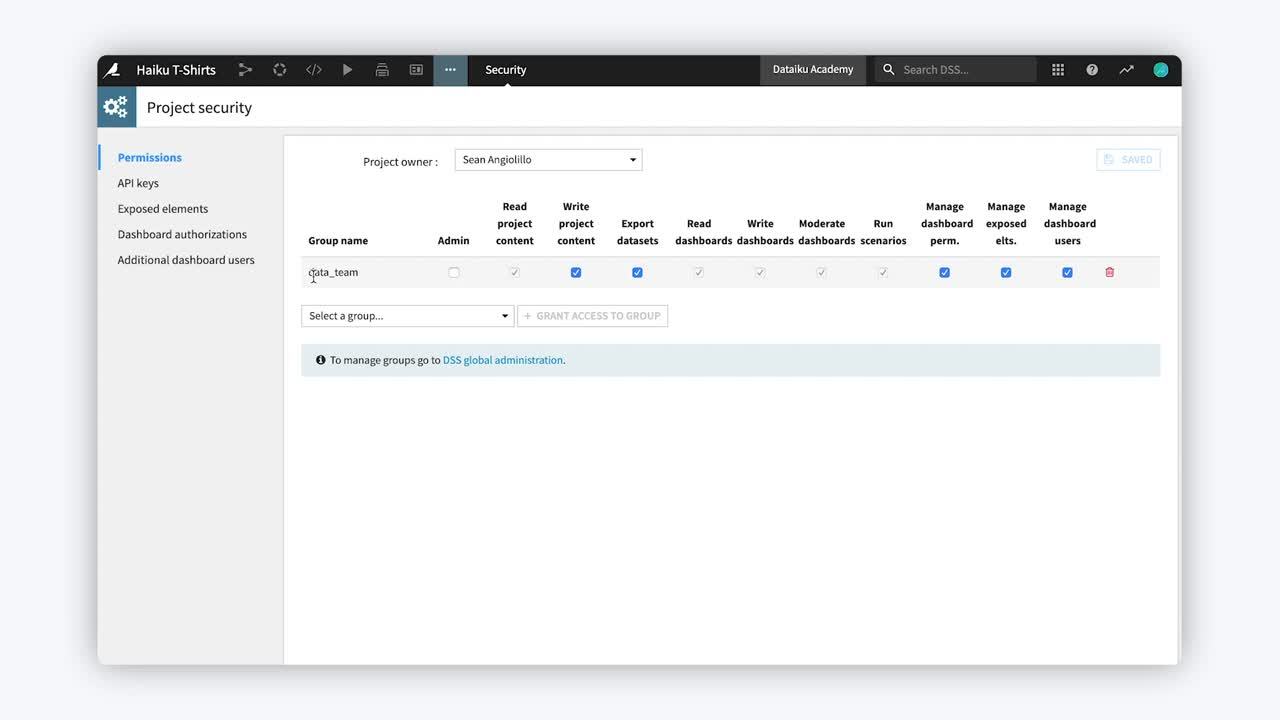Introducing dashboards
Live analytics projects often require reporting tools that give project collaborators and external stakeholders insight into the performance or results of the project. A dashboard in Dataiku is one of the tools that serve this purpose.
First, users can publish elements of a Dataiku project (such as a table, chart, or model report) to dashboards. Next, users can share these dashboards not only with project collaborators, but also a wider group of stakeholders, while still maintaining control over permissions.
Every Dataiku project has a default dashboard, but you can create an arbitrary number of new dashboards.
A dashboard consists of pages.
Each page consists of tiles, which the user can arrange on a grid as needed.
Each tile on a dashboard page holds an insight from the project.
You can add to dashboards many types of insights, such as charts, model reports, Jupyter notebooks, webapps, metrics, and even macros.
Insights most often reference Dataiku objects. For example, you can trace this chart back to the source dataset in the Flow.
See also
For more information on insights, see also:
Managing dashboard permissions and authorizations
Often you’ll want fine control over who can create and share dashboards. For this, you can go to the project’s Security menu from the top navigation bar and access the Permissions panel.
Dataiku provides the option to grant project access to:
User groups
Caution
When granting project access to user groups, an admin must first have created the user groups.
The project creator can share the project with the groups and designate specific permissions of each group with respect to the project at hand.
Individual users
The option to grant project access to individual users removes the need for users to first belong to specific groups, making this option useful for a non-admin.
The reference documentation on dashboards provides a full accounting of all possible permissions. Here you’ll find a few examples of how the permission model based on user groups relates to dashboards.
Project permissions
As shown in the figure below, fellow project collaborators may be members in a group, such as data_team. They may have a wide range of permissions including the ability to Write project content. This implies the permissions to read, write, and moderate dashboards.
Note
Also notice the button for granting access to individuals in the figure above.
Dashboard builders
Also shown above, another group of users, called the viz_team in this example, may be responsible for creating dashboards once the data team has finished building the project Flow.
It might be reasonable to grant users in this group the ability to moderate dashboards. This permission implies the permission to read and write dashboards and manage dashboard permissions and dashboard users. They may also require the ability to read, but not write project content.
With the set of permissions above, users in the viz_team group can create new dashboards or they can add new pages and tiles to an existing dashboard from Dataiku objects. Yet, they can’t modify the project Flow.
When a user adds a new insights, Dataiku issues a warning if no previous user had shared the object with dashboard-only users.
When a project matures, it may be time for more users to discover the dashboard. In this case, the project owner, an admin, or a user with the Moderate dashboards permission can switch a dashboard from the default private to a public setting. This allows those with the correct permissions to find the dashboard on their Dataiku homepages.
Dashboard readers
Finally, you may also have users who should only be able to access a completed dashboard, but not modify its contents in any way.
An admin could assign this restricted level of permission to any group. However, a user with the permission to Moderate dashboards can also grant dashboard access to specific users on the instance.
A dashboard-only user can’t:
Create a new project.
See the project Flow.
Edit, copy, or delete the dashboard. They can only view it.
Inspect the source objects behind any insight.
Exporting dashboards
You’ve now seen many ways in which you can share dashboard access with Dataiku users. However, sometimes you may need to share a dashboard, or pieces within it, externally, outside of Dataiku.
For this, you can export a dashboard as a PDF or PNG file. You can do this manually through the interface, but also automatically through a scenario. You can send exports by mail or store them in a managed folder.









